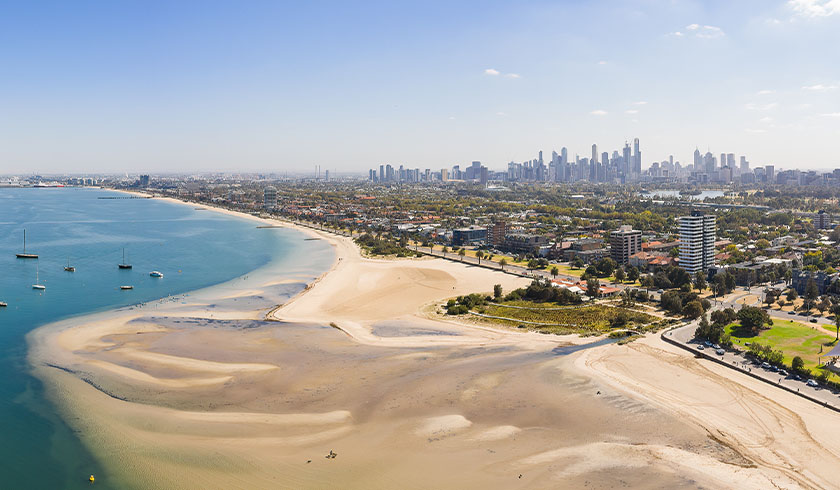Victoria’s ‘Affordable Lifestyle Destinations’ Revealed As New Hotspots
The ability to work remotely from further afield has put many more affordable lifestyle destinations in the spotlight, a recent McGrath Real Estate report found.

Prior to the pandemic, Melbourne was Australia’s fastest-growing city, with hotspots across gentrifying areas, family-friendly locations and lifestyle suburbs.
In 2019, the beachside suburb of St Kilda was Australia’s best performer for capital growth in houses, with the median price up 19.6 per cent to $1,584,805 on the back of surging demand for premium homes.
Joining Australia’s list of top-performing areas for long-term consistent capital growth were the low-profile, family-friendly suburbs of Bonbeach, Carnegie and Templestowe Lower, which have all recorded median house price increases of about 30-40 per cent since 2015.
Looking further back, in 2018, the new elevated rail line attracted families to Templestowe Lower as they were priced out of nearby Doncaster.
In 2017, the regional markets are Geelong and Ballarat were deemed strongest with median house prices rising about 25 per cent since 2017 to $555,000 and $415,000, respectively, although remaining well below Melbourne at $802,551 as of 30 June 2020.
In recent times, jobs growth, business investment, new infrastructure and housing affordability have made these two satellite cities highly attractive to Melbourne families willing to commute back to the CBD each day for work, the report highlighted.
Now, the ability to work remotely from further afield has put many more affordable lifestyle destinations in the spotlight.
According to McGrath: “The Victorian high country is proving to be an early beneficiary of this trend, with growing buyer interest in areas such as Mansfield Shire in the state’s north east.”
“About 2.5 hours from Melbourne and one hour from the regional centres of Shepparton, Wangaratta and Benalla, Mansfield Shire is attracting more treechangers due to its many recreational options, including snow skiing, water skiing on Lake Eildon, horse riding and fishing.”
In response to COVID-19, the Victorian government has launched a $2.7 billion job-creating infrastructure blitz that includes 10 new schools in areas such as Greenvale, Melton South, Deanside and Clyde, as well as upgrades to 57 others, as well as the rebuilding of Clifton Creek Primary School in East Gippsland, which was destroyed in the 2020 bushfires.
New hotspots
McGrath Real Estate’s founder and executive director, John McGrath, listed areas across Victoria that are poised for property gains as Australia recovers from the COVID-19 outbreak:
1. Thornbury
Earmarked as an up-and-coming suburb for many years, Mr McGrath described Thornbury as “a cultural melting pot popular with hipsters, professionals, young families and older migrants who moved in decades ago”.
On average, the suburb is $200,000-$350,000 cheaper than neighbouring Northcote and Fitzroy North but still offers the same great city access via the No. 11 tram that runs every 10 minutes for a 25-minute journey to Spring/Collins Street. Thornbury also offers an array of pubs, boutique shops and cafes on High Street, as well as local schools with great reputation, including Thornbury High and Northcote High.
2. Sunshine
If the Victorian government’s $13 billion 27lm Airport Rail to the CBD proceeds, Sunshine will benefit as the preferred route for the project.
“Sunshine will become a super transport hub the size of Southern Cross Station, offering accommodation, food, retail and commercial spaces. The Sunshine Super Hub will also become a gateway to regional Victoria under the broader Western Rail Plan, which includes the fast rail to Geelong and Ballarat,” according to Mr McGrath.
Identified as a state government priority precinct, Sunshine is set to receive a significant boost to infrastructure, health services and education facilities over the next seven years, which will generate thousands of jobs and service the region’s growing population.
Brimbank Council is aiming to make Sunshine the capital of Melbourne’s west by 2050.
3. Hawthorn
Hawthorn’s median house price broke the $2 million mark in the June 2020 quarter, but apartments remain affordable at a median $677,000, despite 15.2 per cent growth over the same period.
Only 6km from Melbourne’s CBD and 13 minutes by train from Glenferrie Station to Flinders Street Station, Hawthorn is surrounded by some of the city’s most expensive and prestigious suburbs, including Toorak, Camberwell, Kew and Hawthorn East.
Mr McGrath said: “Apartment owners benefit from the same lifestyle perks and amenities of these illustrious neighbours but without the price tag.”
4. Coburg North
Popular among 30-somethings with large Italian and Greek communities, the ‘hidden hub’ of Coburg North has a transformation underway, according to Mr McGrath.
Just 11km north of the city and 20 minutes’ drive to Melbourne Airport, Coburg North is benefitting from the ripple effect of rising house prices in neighbouring Coburg and Brunswick, as well as a unique and wonderful cultural combination. Coburg North’s median house price is $170,000 cheaper than Coburg.
5. Kilmore - Regional Vic
Kilmore draws young families seeking a country lifestyle within commuting distance of Melbourne. The median house price is $443,750, about 45 per cent cheaper than Melbourne, all while boasting services and amenities such as golf course, hospital, council-owned gym and pool, cafes and shops.
The Kilmore Structure Plan to cater for the region’s growth includes street widening, new footpaths and a bypass off the Northern Highway for improved accessibility and safety.
